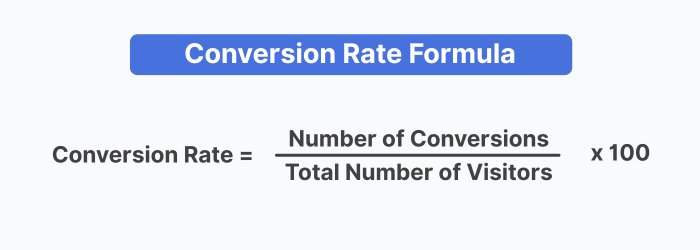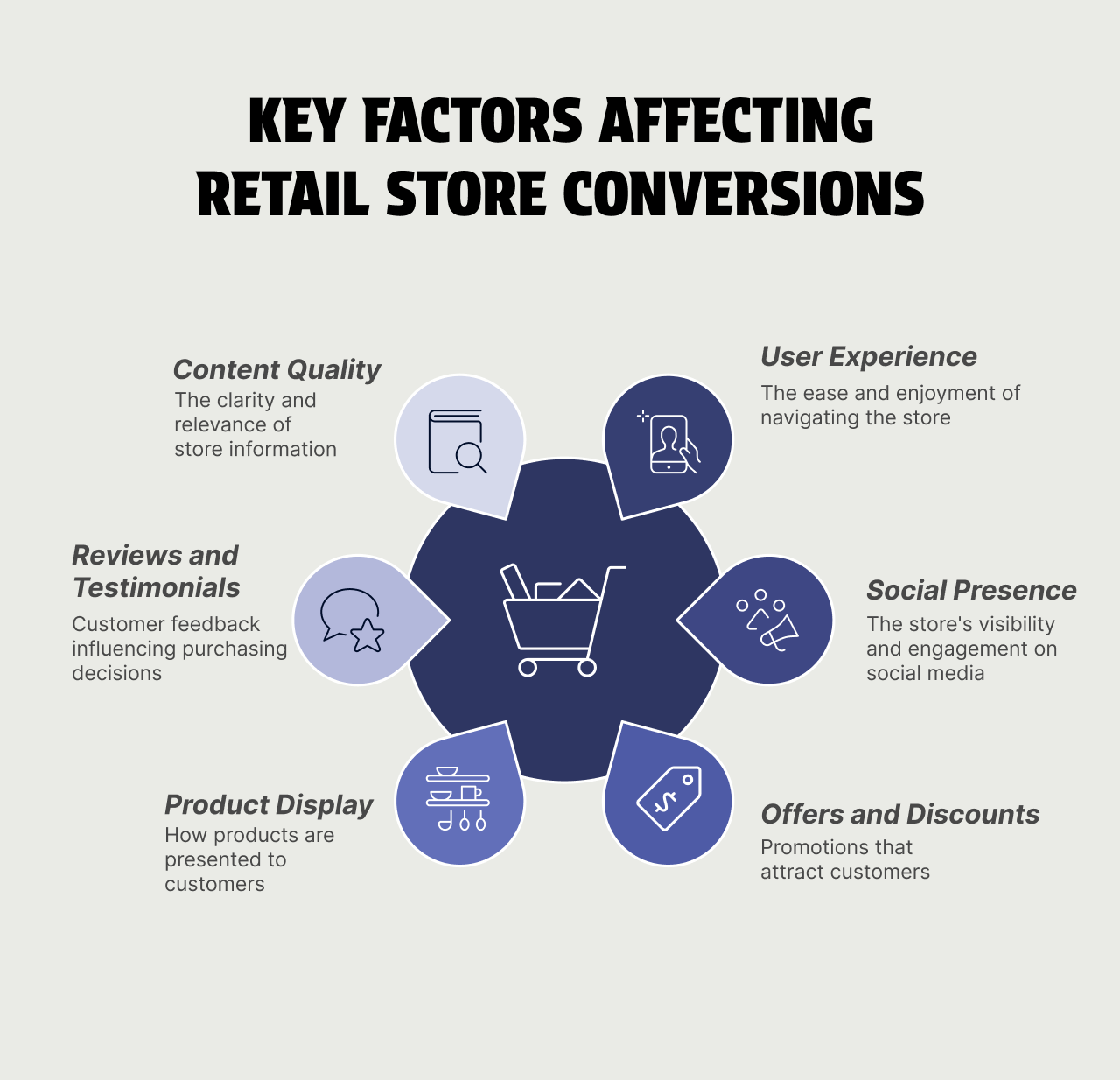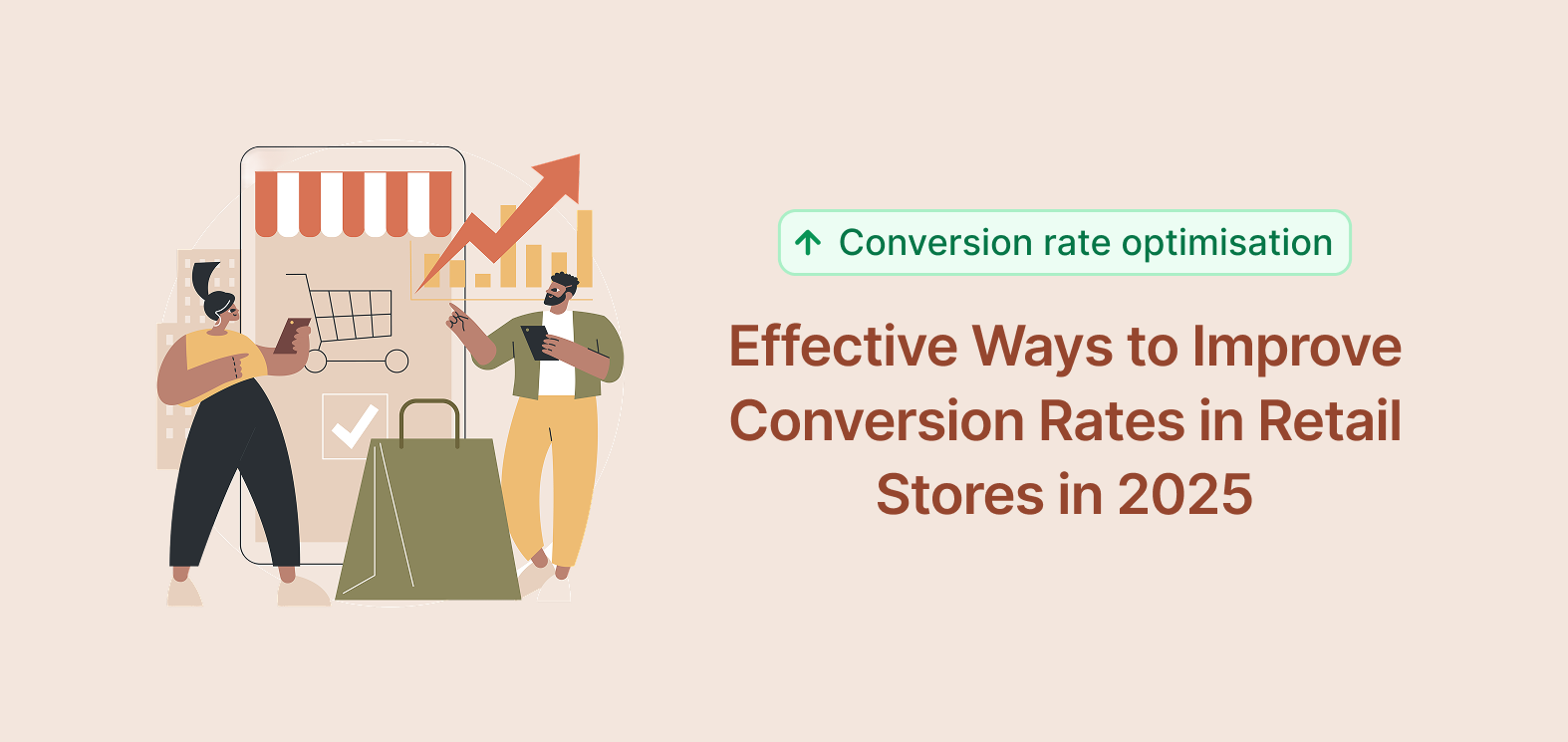Conversion is the most valuable metric for any retail or e-commerce store. It is the deciding factor for a successful retail business.
Most customers get stuck in the second or third stages of the conversion funnel. Thus, there is a need for conversion rate optimization in retail to encourage more conversions, such as order placement, ebook downloads, newsletter signups, or store visits.
Let’s explore Effective ways to improve conversion rates in retail and e-commerce stores. But first, we will see the actual definition of conversion rate.
What is a Conversion Rate in Retail?
In retail & eCommerce, Conversion simply refers to the process of converting a potential lead into purchasing the product/service.
To put it more simply, it is counted when a customer enters your store - whether it be online or in person - and completes the intended action, like buying something.
Conversion is not just about making sales; it is more about creating an engaging online shopping experience for customers.
What is Conversion Rate Formula?
Conversion Rate Formula calculates the number of visitors who complete this activity (make a purchase) out of all visitors or interactions on the website.
It is a percentage that suggests the number of people engaged with the brand’s product or service and ended up buying it.

Example: If 5,000 people visit your store and 200 make a purchase, the conversion rate is (200/5000)*100 = 4%.
Why Should Retailers Focus on Conversion Rate Optimization (CRO)?
“The higher the conversion rate, the better the user’s shopping experience.”
As we know, online shopping is not a linear process; customers take time to check different products, websites, and reviews before making a final decision to buy something. Optimizing the conversion rate can improve the user’s website experience and generate more sales.
Here are some of the key benefits of optimizing conversion rates:
1. Helps to understand the user journey
You can use analytics and reporting tools to see how many people converted, added a product to their cart, or simply expressed interest in one product. Monitoring and optimizing the conversion rate can help you bridge the gap between the consideration and conversion stages of the marketing funnel.
2. Improves sales and revenue
Using the impactful conversion rate optimization strategy can improve the number of sales significantly. Users often make purchases when they find convenience in navigation, correct pricing, and good customer support. You can get more conversions and less page abandonment by optimizing your website.
3. Uncovers Areas of Optimization
Through optimizing conversion rates, retailers can easily pinpoint improvement areas, including product displays, customer service, and page or store design. This allows brands to reduce the bounce rate issue by fixing its cause, which can improve overall website visibility and upgrade customer experience.
What Factors Impact Retail Store Conversion Rates?

Imagine you are generating a good amount of traffic on your Shopify or WooCommerce store, but the conversion rate is a mere 1-2%, which is quite low by industry standards. These are the most common factors that impact the conversion rate in the retail stores negatively:
1: User Experience (UI/UX)
The User Interface (UI) of eCommerce websites is a key factor in converting leads into customers. Design and technical proficiency must be taken into consideration when optimizing the retail store. Many of the stores have bounce rates due to the slow loading time of the pages.
2: Social Proof & Reviews
Social presence is more essential than ever. B2C brands that leverage social media platforms engage more with customers. Social media is among the best methods for reaching the appropriate audience. Ignoring social proof can significantly reduce the conversion rate.
3: Pricing & Offers
Everyone enjoys taking advantage of sales and discounts. Brands should anticipate a high conversion rate if they provide seasonal promotions and super savings offers. The price drop is a major factor influencing retail stores' conversion rate.
4 Product Display & Quality
The quality and presentation of a product can make or break a customer, regardless of how much money is spent on marketing. Poor quality can harm the brand's reputation and result in low conversion rates. Interactive product displays can increase user engagement fourfold and have a favorable impact on conversion rates.
5: Reviews & Testimonials
In a survey posted on Fera, 30% of customers concur that UGC boosts their confidence when making purchases, and the number of sales increased by 18% on average as a result of reviews. Conversion rate is undoubtedly greatly impacted by less or negative product reviews.
6: Poor Content & Messaging
The content of the product, home, about us, and checkout pages does not comply with SEO and Google content guidelines. Inadequate or incorrect information about the product or price can lead to mistrust among customers. Missing FAQs, support, returns, and cancellations can also leave users feeling disappointed.
How to Improve Conversion Rates in Retail: 10 Proven Tips

Tip #1: Create Informative Product Pages
The product page should contain all the necessary information about the product details, specifications, use cases, and benefits. CTA buttons should be placed in the right spots, and a product review section should be included. Reading reviews on the website itself can increase sales.
- Contact Us: A Contact Us page with a Contact Us form, phone number, social media handles, postal address, and email ID.
- FAQs: A well-designed FAQ page directs users to the information they need, and significantly improves the usability and sales of the website.
Tip #2: Use Engaging Product Displays
- Premium-Quality Images: The product’s image quality should be top-notch.
- Product Videos: Using a video on your landing page can boost conversion by 80%.
- Interactive Display: Use rich media and data-backed interactive display ads in place of static images.
Also Check: 8 Brilliant Interactive Ad Examples (with Live Preview)
Tip #3: Enhance the Retail Store Experience
- UI/UX: The user interface should be seamless, simple to use, responsive to user demands, and compatible with all devices.
- Loading Time: The ideal loading time for a retail website should be less than 3 seconds on a desktop and less than 5 seconds on mobile.
- Bounce Rate: Ideally, an eCommerce store should have a lower bounce rate, but top brands try to keep their bounce rate between 30% and 50%.
Try Kappax for creating retail shoppable ads in the form of videos to generate more conversions on the website. Book a free demo now.
Tip #4: Offer Strategic Sales and Discounts
- Create FOMO: Bring limited-time offers that create a sense of urgency and FOMO among users. Customers are encouraged to make quick choices and place the order immediately for a good deal. This strategy can increase sales and foster brand loyalty if executed correctly.
- Offer Free Shipping and Rewards: Set a minimum order value or even provide free shipping on orders. Combining it with rewards, points, or cashback can be a good strategy to encourage more sales in the future.
- Seasonal Sale and Discount: Offer discounts on some special occasions, like New Year, Christmas, and Black Friday. It creates a buzz around the brand and can maximize your conversion rate for the season.
Tip #5: Simplify the Checkout Process
- Enable Guest Checkout: Enable the guest checkout option for those who arrive on the page through ads without the need to register. Reduce the number of steps and simplify the checkout process. Many users abandon their carts because they have to register or create a profile.
- Multiple payment options: Collaborate with multiple payment providers and allow smooth transactions through credit card, debit card, and country-specific payment portals.
Tip #6: Build Trust and Credibility
- Data privacy: To ensure clients that customers’ data is secure, display trust signals like SSL certificates and badges and use secure payment methods. The site must also have a privacy policy that outlines the kinds of personal information it collects from users and how it uses and protects that information.
- Return and Cancellations. A page dedicated to product exchange, cancellation, and return policies should be mentioned clearly. Easy return or exchange builds trust and provides freedom to customers on that front.
- Live support: Enable a live chat option through AI or a chatbot that can assist customers regarding any product query. Offering a live support feature can help them in real time to make a decision.
Tip #7: Use Smart Marketing Tools
- Retail store software: There are ample eCommerce pre-built software solutions like Shopify, Magento, and WooCommerce available for building highly scalable retail businesses. You get all the required features preloaded in the retail software. It’s easy to use, highly engaging, and supports an easy checkout process.
- eCommerce marketing software: Brands are incorporating onsite personalization features where the store's content, messaging, and product recommendations cater to each visitor's interests and habits through dynamic personalized ads. Use tools like Omnisend, Mailchimp, Drip, and Klaviyo for automated email and SMS marketing.
Tip #8: Ensure Mobile Responsiveness
- Easy Navigation: Retailers with mobile apps usually get increased conversion rates as people are using mobile devices for shopping online. Choose easy-to-use themes and ensure that navigation elements, buttons, and product photos are all user-friendly on smaller displays.
- Fits Mobile Screen: Optimizing your website for mobile visitors can increase conversion, as a significant amount of online buying takes place on mobile devices. Make sure your retail store is fully responsive and provides a great mobile shopping experience.
Tip #9: Leverage Social Media Channels
- Social Reviews: Research has repeatedly suggested that products with more reviews and higher star ratings typically sell better. Reviews on social media platforms work as a strong psychological trigger, displaying the number of purchases and product reviews that boost confidence in the product and hence impact the conversion rate.
- UGC Content: Adding user-generated content (UGC) to e-commerce product pages boosts conversions by 161%. Additionally, it can be an effective tool for building relationships with customers and making the experience more interesting. UGC increases sales by fostering loyalty and trust.
- Social Media Ads: Apps like Facebook and Instagram offer engagement as well as conversion ads as a goal for running ads. The use of remarketing campaigns for customers who engaged with the store once likely increases the rate of conversion. This is one of the most efficient strategies to improve your retail conversion rate and maximize ROI.
Tip #10: Optimize for Search Engines
- Content Marketing: Increase organic traffic to your Shopify or Magento store by writing engaging and useful blog and video content. Compose articles on your products, services, and industry to benefit readers and boost natural engagement with the right set of audiences.
- Product Pages SEO: Follow healthy practices for product page on-page as well as off-page SEO. Detailed keyword research, long URLs, meta tags, and content optimization are some of the recommended checklists for each product page of the store.
- Schema Markup: A schema is a structured data set that uses compelling elements to define a webpage's content. It helps search engines understand crucial e-commerce data, such as product reviews and prices. The product schema gives users a lot of information regarding product availability and price changes.
How to Measure Conversion Rate Effectively in Retail
1. Analyze Your Conversion Funnel
Examine your conversion funnel to determine the points at which customers choose not to engage further. They may see multiple products on the site and close the website or add products to the cart and just vanish. An eCommerce business can boost sales and revenue and improve its customer retention rate with the use of an optimized eCommerce conversion funnel.
2. Run A/B Tests
A/B testing compares multiple versions of a product to see which works better. Run an A/B test to find out which version of your page generates more conversions, and conduct trials using tools like Google Optimize or VWO updates.
Test product pages, landing pages, ad copies, and sales pages to see which ones are most effective in increasing conversions. Experiment with headlines, content, and designs to understand what resonates best with the audience.
3. Use Analytics Tools
It is essential to monitor and optimize conversion rates regularly. To track the success of your advertising strategy and identify conversion process drop-off points, use tools like Google Analytics, Facebook Ads Manager, or Shopify Analytics.
These tools can be used to track important metrics such as cost per acquisition (CPA), return on ad spend (ROAS), conversion rate, and click-through rate (CTR).
Boost Conversions with KappaX Interactive Shoppable Ads
We can assist you in developing and automating customized, cross-channel display ads for retail ****and eCommerce. Use the NoCode Editor to repackage your static ad into an engaging interactive experience. Increase engagement and conversion rates by converting passive viewers into active contributors.
Book a demo and get an extensive toolkit for producing interactive, aesthetically pleasing content in a variety of media forms. Utilize real-time customization and data integration to develop ads that can be modified as per the customer’s interests and preferences.
Don’t miss checking out our featured ad experiences collection, which we have created for leading clients in the industry. Join us to develop something unique for your business!
Final Thoughts
Boosting the conversion rate for retail stores demands a full-fledged strategy. It's not just about the quantity of sales; it’s more about the overall quality experienced by the customers. As Michael LeBoeuf correctly stated,
"A satisfied customer is the best business strategy of all.”
There are numerous methods to increase the conversion rate of your retail store, ranging from streamlining the checkout process and store design to implementing personalized recommendations and trust-building techniques. Make sure to consistently improve the consumer journey to raise the possibility of a successful sale, and always test and optimize your store's features to determine what works best for your audience.
